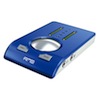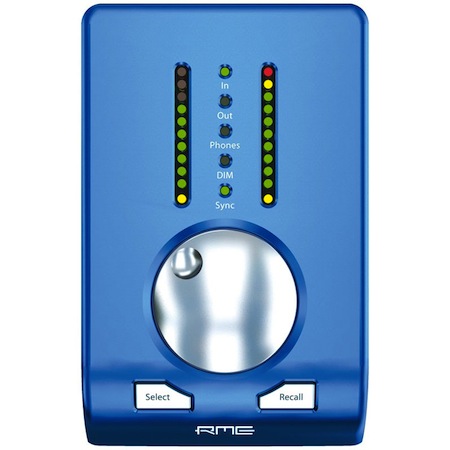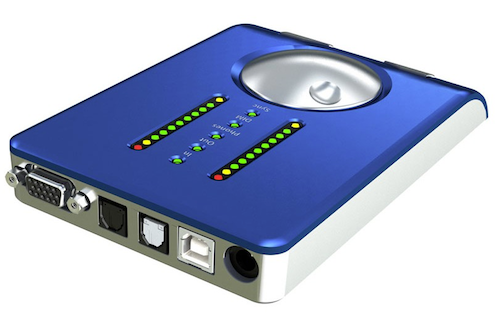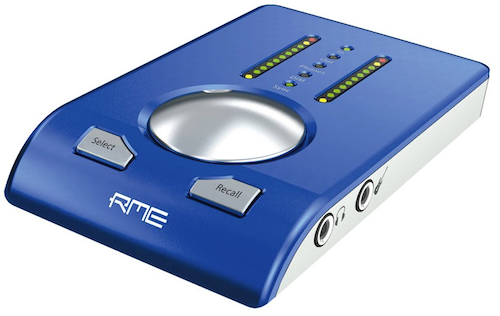RME BABYFACE REVIEW
Posted on Fri 08 July 2011 in entries
 The Babyface… I’ve often wondered exactly what these products are! I mean, I’ve seen them sat on the shelves in our warehouse, but their soothing blue packaging displaying a large picture of a wide-eyed baby in a nappy always made me think that this was a product for the absolute beginner… either that or it was a box of Pampers! How wrong I was!
The Babyface… I’ve often wondered exactly what these products are! I mean, I’ve seen them sat on the shelves in our warehouse, but their soothing blue packaging displaying a large picture of a wide-eyed baby in a nappy always made me think that this was a product for the absolute beginner… either that or it was a box of Pampers! How wrong I was!
Luckily, I was asked to do this review, otherwise I would probably still have had that perception of the RME Babyface! Although, now I come to think of it, how naïve my original thoughts were! Would a company really plaster a patronising picture of a baby on the front of a product for the amateur? Or was I expecting that this was actually a product designed for the new born? I know they say that you should start young if you want the best chance of making an impression in the music industry, but this would have been taking it a bit too far I think! I know that Justin Bieber seems to be all the rage in the pop world at the moment but I doubt even he began singing before he had started eating solid foods! Although… that could be an idea for another product in the range… any takers for the RME Bieberface? No?
RME BABYFACE – NOT FOR DUMMIES!
The RME Babyface is a rather impressive audio interface. I imagine that it got its name because despite being housed in a very simplistic, fresh looking case, it actually contains a deceptively powerful and mature architecture. In fact, it uses pristine sounding 192 kHz AD and DA converters, two reference class microphone preamps and SteadyClock analogue circuitry design. As RME state, they wouldn’t give their newborn anything second class! Either that or it simply got its name because it's small, and it's an interface. Either way works for me though!
 ](https://www.absolutemusic.co.uk/rme-babyface-usb-audio-interface.html)
](https://www.absolutemusic.co.uk/rme-babyface-usb-audio-interface.html)
The RME Babyface also comes bundled with the impressive TotalMix FX software, which gives you a simple way to route and mix your signals from the convenience of a computer screen, whilst also chucking in a host of useful effects.
RME BABYFACE – SMOOTH AS A...
I really like the sleek design of the RME Babyface and I think that its baby blue exterior makes for a really nice looking product on your studio desk. The large dial that sits below the highly-responsive LED meters is a real treat to work with and the ergonomic curved front end, which angles the two buttons of the Babyface towards you is a nice little touch both for artistic design and practicality. In reality, this product could just as easily have been called the RME Futureface, as it definitely has that futuristic look to it. I can just imagine Captain Kirk holding one in his hand and swiping the dial to 'stun' mode! Plus, on top of all this, it has an extremely sturdy build and really feels like a heavy-weight professional product.
RME BABYFACE – CONNECTIONS
If you have never come across a product like this before then you may be wondering how such a small and portable device boasts such extensive connectivity. The key feature here is the breakout cable, which attaches to the back of the RME Babyface with one connection, but then ‘breaks out’ into a number of other connections, including 2 analogue XLR inputs (for microphones or line level signals), 2 XLR outputs (for hooking the Babyface up to speakers, etc), 2 standard MIDI connections (In and Out) and a ¼” TRS connection to carry a stereo signal to a pair of connected headphones (or whatever else you want). One important point to take away here is that the headphone outputs are separate from the main outputs and so can be used to carry a separate signal from the main outs if you wish. This kind of flexibility is useful if for example, you need to route a click track to a performer's headphones, whilst simultaneously playing the main recording out of a pair of connected speakers.
 ](https://www.absolutemusic.co.uk/rme-babyface-usb-audio-interface.html)
](https://www.absolutemusic.co.uk/rme-babyface-usb-audio-interface.html)
If you look down the right-hand side of the Babyface, you will also notice two additional connections. The first of these is an additional headphone output. This headphone output is linked to the headphone connection on the breakout cable, meaning that you actually have the flexibility to hook up two pairs of headphones to the RME Babyface if you so need.
Next to this headphone connection is a ¼" jack instrument input. All you need to do is plug in your guitar, switch one input to ‘Hi-Z’ input mode and make your recording! The fact that these two connections are situated on the side of your interface is especially handy, as it gives you easy access to the connections that you are most likely to be fiddling around with! Whilst the breakout cable is handy, it would be a little annoying to have to sift through all the cables every time you wanted to plug your guitar or headphones in, so it is good that these connections are easy to get to, leaving the breakout cable to handle things that are most likely to remain permanently plugged in.
Alongside all the analogue inputs and outputs are a number of high-quality digital connections as well! On the back of the RME Babyface, you will also find an optical TOSLINK I/O connection and an ADAT port with SMUX support or SPDIF optical at 192kHz.
Alongside a standard ultra-fast USB 2.0 connection and an optional power socket, that forms everything you need to know in terms of connections on the RME Babyface…
RME BABYFACE – HOW DOES IT SOUND?
As you would expect from an RME product, it sounds thouroughly awesome! Whether you are just after a product to fit in with your home studio, or you are making professional recordings, you shouldn’t be disappointed with the Babyface.
The XLR and TRS connections on the breakout cable make use of RME’s analogue circuit design and as far as I can tell, they sound brilliant! Recordings sound as clean and clear as I could wish for as I listen back through my crisp Focal CMS65 monitors. In fact, with the latest generation AD and DA convertors that the RME Babyface has, it allows you to record up to sample rates of 192kHz and with a SNR (signal-to-noise ratio) of an incredible 115dB, so there is no wonder that recordings sound so pure and detailed.
Although I didn’t make use of this functionality, it is also worth noting that the RME Babyface incorporates SteadyClock technology, which RME claim ‘guarantees’ pristine sound quality when you clock to an external digital source.
Recording microphones, guitars and line levels all sounded excellent with the Babyface. In fact, it makes use of high-end digitally controlled mic pre-amps, each of which provide individually switchable phantom power. The mic preamps in the Babyface feature a gain of up to 60dB, adjustable in steps of 3dB over a range of 51dB and all levels are completely recallable via the included software (more on this in a minute).
RME BABYFACE – HOW DOES IT WORK?
With so few controls (just a single dial and two buttons), you would be forgiven for thinking that the Babyface doesn’t offer you much in the way of control, but you would be very wrong! The fact that there are not many physical controls simply makes the Babyface highly portable, as you can achieve anything and everything that you would expect from a standard interface, using what RME offer you.
 ](https://www.absolutemusic.co.uk/rme-babyface-usb-audio-interface.html)
](https://www.absolutemusic.co.uk/rme-babyface-usb-audio-interface.html)
You will notice that between both LED meters, there are an additional 5 separate LEDs, each with a label next to them. Whilst the bottom LED (Sync) merely acts as an indicator light (to signal when synchronisation has been achieved with a digital optical input), the first four LEDs light up to indicate a particular mode that the Babyface is in and as such, what the large dial will have control over. The options are:
• ‘In’ – use the dial to control the input signal level of each channel.
• ‘Out’ – use the dial to control the output volume of the RME Babyface.
• ‘Phones’ – use the dial to control the headphone output level.
• ‘DIM’ – set a dim level for the RME Babyface. This is a level that the output will jump to if you press the dial – yes, the dial is also a secret button! So for example, if you’re in the middle of monitoring a recording and you have to quickly answer the phone, press the dial to activate the dim volume and then press it again once you are done to return the volume of the Babyface back to exactly how you had it set before.
You can probably even guess exactly how you switch between all these different modes. You got it! It’s with one of the buttons on the bottom – the one on the left in fact. It’s all completely straightforward and intuitive.
There are however a couple of extra little things that you may be wondering… for example, if you have one microphone hooked up to each input and both are picking up different signals, how do you adjust the level of each input independently to create the best mix? The answer to that is that it is very easy! Simply use the selection button to activate ‘In’ mode, then press the dial once to adjust the level for the first input, press it again to adjust the level of the second input and press it a third time to adjust the levels of both inputs together. You can cycle round like this as much as you want until you find the optimum settings for each channel.
The second thing that you may be wondering is, what does the second button on the front do? This button triggers the Babyface’s Recall function. For example, if you work in the studio at a set reference level, then you can set this level within the Babyface and recall it really easily. This is an excellent feature for when you are checking how your mix sounds at different levels, but ultimately want to return to your reference level for further work.
RME BABYFACE – INCLUDED SOFTWARE
The RME Babyface comes bundled with the intuitive TotalMix FX software. Essentially, this software gives you direct access to mixing and routing within the Babyface itself, by offering you a fader, solo/mute buttons, a pan control, plus 3-band EQ, low cut, etc, for each channel of the Babyface. This version of TotalMix FX also gives you a separate FX send bus for all inputs and software playback channels, which feeds both a Reverb and Echo effect engine. Plus, each output channel includes an FX return control for the FX output signal.
If you are used to using any type of mixer (hardware or software) then you should pick up how the software works extremely easily. Saying that, even if you aren't familiar with how a mixer works, just have a quick flick through the manual and you should pick up the basics in no time at all as it really isn't anything overly complicated.
RME BABYFACE – SUMMARY
All in all, I think that RME have come up with one stunning product here. I think that naturally, with its one-dial and mobile design, people will always draw comparisons with the Apogee Duet.
Whilst I slightly prefer the sleek, James Bond-style look of the new Apogee Duet 2 and also prefer working with the more detailed OLED display, I have to admit that as a complete product, the Babyface pips the Duet to the post. For starters, the Apogee Duet is only Mac compatible… the Babyface works on both Mac and Windows systems. Next up, the Apogee Duet doesn’t cater for MIDI… once again, the RME Babyface does! I would also argue that the general design of the Babyface is better than that of the Apogee Duet… the fact that the Babyface gives you an easily accessible guitar input on the side of the unit is a simple touch but such a handy one!
 ](https://www.absolutemusic.co.uk/rme-babyface-usb-audio-interface.html)
](https://www.absolutemusic.co.uk/rme-babyface-usb-audio-interface.html)
However, perhaps the main advantage of the RME Babyface over the Apogee Duet is that the Babyface’s digital connections make it highly expandable, allowing you to connect it with another compatible device (such as the RME Octamic II) to give you a whole load more connectivity – up to 10 analogue input and 12 output channels to be precise! This means that you can have both a quality studio interface, with a plethora of I/O and a handy portable interface for capturing sound on the move, or for live events! There’s also no need to worry about creating digital connections as the Babyface automatically detects SPDIF or ADAT input signals, making everything extremely straightforward.
Although it may well have those babyfaced charms, this product is certainly not something to be underestimated and I would have no hesitation in recommending this crystal-clear sounding device to anyone after a portable interface with amazing quality and excellent expansion options. So, click the link below to check out the RME Babyface for yourself and also see what other people had to say on this interface by selecting the ‘Reviews’ tab on the product page. You won’t be disappointed!
For more information on the RME Babyface, click the link below or give us a call on 01202 597180.
******If you're interested in buying and you have seen it cheaper elsewhere, please call us or use our
As well as receiving our first rate customer service you can also claim money off your next purchase with our loyalty points scheme and receive a 3 year warranty if you sign up to our FREE VIP Club (click here for more infomation). Many of our items also come out on a FREE next-day delivery service to mainland UK customers, so you won't be left waiting!
Also, if you want to keep up with all our latest offers, competitions, news and videos, why not follow us on Facebook and Twitter?
